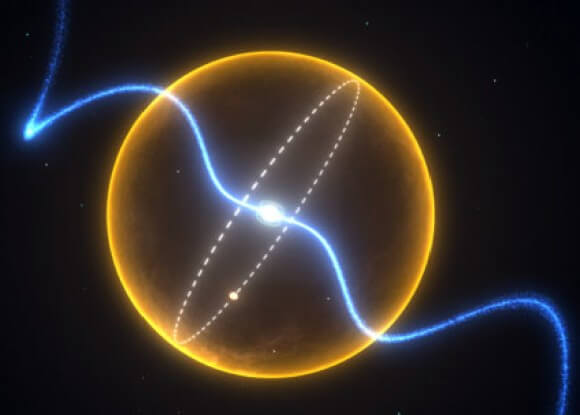A companion star has lost its atmosphere and most of its mass to the pulsar it orbits, what remains is the core - an extinguished star the size and mass of a planet made of diamond
Tammy Plotner, Universe Today

Four thousand light years from us in the Serpent group there is a star with a heart that beats every few thousandths of a second. A team of international researchers from Australia, Germany, Italy, Great Britain and the USA, including Prof. Michael Kramer from the Max Planck Institute for Radio Astronomy in Bonn, Germany, are listening to him. They use the 64 meter diameter Parkes radio telescope in Australia. The companion star in the system is a very low mass white dwarf that has been transformed into a planet made of pure diamond.
The density of the planet is at least like that of platinum, and this provides us with a clue to its origin" says the head of the research team, Prof. Matthew Bayles from the Swinburne Institute of Technology in Australia. Bayles leads the Dynamic Universe team in a new large-scale astronomical initiative, the Center of Excellence for Astrophysics (CAASTRO) currently on sabbatical at the Max Planck Institute for Radio Astronomy.
Like a lighthouse, J1719-PSR 1438 systematically emits radio signals around it. When the researchers noticed a specific modulation every 130 minutes, they realized it was a signature of planetary dimensions. Given the distance of its orbit, it is very likely that the companion is the core of what was once a massive star whose material was pulled by the pulsar's gravity.
"We know of very few other systems of this type, known as ultra-compact low-mass X-ray binaries, which may develop according to the above scenario and may represent the prototype of pulsars such as J1719-1438", said Dr. Andrea Fossanti from the IANF Observatory in Cagliari, Italy.
"When almost all of its original mass is gone, very little is left of the companion star for it to turn into carbon and oxygen - unless it is the core of a star that was previously active and managed to produce these compounds and therefore stars that are still rich in lighter elements such as hydrogen and helium will not fit into the equation. The star is so compressed that its material is more like a diamond.
The final fate of the binary system will be determined by the mass and orbital period of the donor star at the time of the mass transfer. The rarity of pulsars with a cycle time of milliseconds with a companion the size of a planet means that the production of "exotic planets" is the exception, and requires unique conditions," says Dr. Benjamin Steppers from the University of Manchester.
"The new discovery surprised us. But there is certainly a lot to discover about the physics of pulsars in the coming years," concluded Michael Kramer.

7 תגובות
A simulated site floating in outer space
No star of hemorrhoidal gold could have been a fantasy
It's a shame that it is not closer to us to the earth in addition to the moon, it is an attraction to look at it and admire its immense beauty
De Beers doesn't need this star... there are more than enough diamonds on Earth too.
In fact, they purchase most of the diamonds directly from the mines in order to prevent a price drop.
And in the next article in the series: an ambitious space exploration project from De Beers
The diamond price should drop in response to this